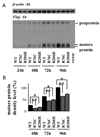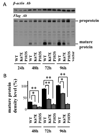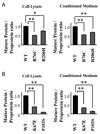Impaired production of BMP-15 and GDF-9 mature proteins derived from proproteins WITH mutations in the proregion
- PMID: 20547206
- PMCID: PMC2934881
- DOI: 10.1016/j.mce.2010.05.017
Impaired production of BMP-15 and GDF-9 mature proteins derived from proproteins WITH mutations in the proregion
Abstract
Mutations in the bone morphogenetic protein-15 (BMP-15) and growth and differentiation factor-9 (GDF-9) genes have been identified in women with primary ovarian insufficiency (POI) and mothers of dizygotic twins. Here, we show that biological activities of the conditioned media from human embryonic kidney 293F cells transfected with two representative BMP-15 and GDF-9 mutants identified in the affected women have significantly reduced biological activities compared with the corresponding wild-type. Moreover, this difference is due to decreased production of the mature proteins, attributed most likely to impaired posttranslational processing of the proprotein. As genetic studies of the BMP-15 and/or GDF-9 genes in ewes established that a reduction of these proteins is associated with an increased ovulation rate, it is conceivable that women affected with these mutations may have an increased probability of bearing dizygotic twins during active reproductive ages before diagnosis with POI at later ages due to an earlier exhaustion of ovarian reserve.
Copyright (c) 2010 Elsevier Ireland Ltd. All rights reserved.
Figures








Similar articles
-
Integral role of GDF-9 and BMP-15 in ovarian function.Mol Reprod Dev. 2011 Jan;78(1):9-21. doi: 10.1002/mrd.21265. Epub 2011 Jan 11. Mol Reprod Dev. 2011. PMID: 21226076 Free PMC article.
-
BMP15 Mutations Associated With Primary Ovarian Insufficiency Reduce Expression, Activity, or Synergy With GDF9.J Clin Endocrinol Metab. 2017 Mar 1;102(3):1009-1019. doi: 10.1210/jc.2016-3503. J Clin Endocrinol Metab. 2017. PMID: 28359091
-
Functional and molecular characterization of naturally occurring mutations in the oocyte-secreted factors bone morphogenetic protein-15 and growth and differentiation factor-9.J Biol Chem. 2004 Apr 23;279(17):17391-6. doi: 10.1074/jbc.M401050200. Epub 2004 Feb 17. J Biol Chem. 2004. PMID: 14970198
-
GDF-9 and BMP-15 direct the follicle symphony.J Assist Reprod Genet. 2018 Oct;35(10):1741-1750. doi: 10.1007/s10815-018-1268-4. Epub 2018 Jul 23. J Assist Reprod Genet. 2018. PMID: 30039232 Free PMC article. Review.
-
[Progress in exploring genes for high fertility in ewes].Yi Chuan. 2011 Sep;33(9):953-61. doi: 10.3724/sp.j.1005.2011.00953. Yi Chuan. 2011. PMID: 21951796 Review. Chinese.
Cited by
-
Genome-wide association studies identify two novel BMP15 mutations responsible for an atypical hyperprolificacy phenotype in sheep.PLoS Genet. 2013 Apr;9(4):e1003482. doi: 10.1371/journal.pgen.1003482. Epub 2013 Apr 25. PLoS Genet. 2013. PMID: 23637641 Free PMC article.
-
A Major Gene for Bovine Ovulation Rate.PLoS One. 2015 Jun 5;10(6):e0129025. doi: 10.1371/journal.pone.0129025. eCollection 2015. PLoS One. 2015. PMID: 26046917 Free PMC article.
-
Genetics of primary ovarian insufficiency: new developments and opportunities.Hum Reprod Update. 2015 Nov-Dec;21(6):787-808. doi: 10.1093/humupd/dmv036. Epub 2015 Aug 4. Hum Reprod Update. 2015. PMID: 26243799 Free PMC article. Review.
-
Unique bioactivities of bone morphogenetic proteins in regulation of reproductive endocrine functions.Reprod Med Biol. 2011 Apr 14;10(3):131-142. doi: 10.1007/s12522-011-0082-9. eCollection 2011 Sep. Reprod Med Biol. 2011. PMID: 29662354 Free PMC article. Review.
-
Alterations in follicular fluid BMP-15 RNA expression in women undergoing controlled ovarian hyperstimulation.Turk J Med Sci. 2020 Aug 26;50(5):1247-1253. doi: 10.3906/sag-2002-208. Turk J Med Sci. 2020. PMID: 32304195 Free PMC article.
References
-
- Albright F, Smith PH, Fraser R. A syndrome characterized by primay ovarian insufficieny and decreased stature. Am. J. Med. Sci. 1942;204:625–648.
-
- Bakalov VK, Anasti JN, Calis KA, Vanderhoof VH, Premkumar A, Chen S, Furmaniak J, Smith BR, Merino MJ, Nelson LM. Autoimmune oophoritis as a mechanism of follicular dysfunction in women with 46,XX spontaneous premature ovarian failure. Fertil. Steril. 2005;84:958–965. - PubMed
-
- Chemaitilly W, Mertens AC, Mitby P, Whitton J, Stovall M, Yasui Y, Robison LL, Sklar CA. Acute ovarian failure in the childhood cancer survivor study. J. Clin. Endocrinol. Metab. 2006;91:1723–1728. - PubMed
-
- Conway GS. Premature ovarian failure. Br. Med. Bull. 2000;56:643–649. - PubMed
-
- Coulam CB, Adamson SC, Annegers JF. Incidence of premature ovarian failure. Obstet. Gynecol. 1986;67:604–606. - PubMed
Publication types
MeSH terms
Substances
Grants and funding
LinkOut - more resources
Full Text Sources
Research Materials

